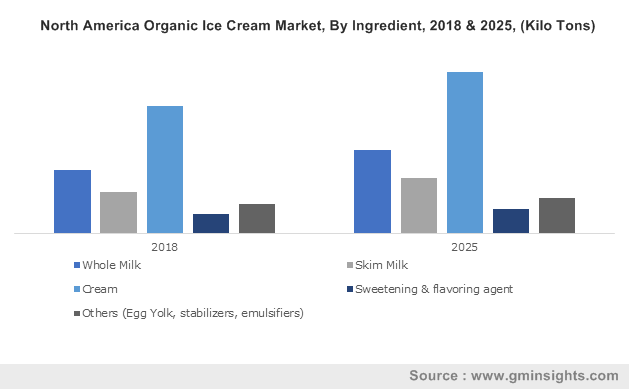Top 3 trends impacting organic ice cream market growth, U.S. to be one of the most lucrative business avenues over 2017-2024
Publisher : Fractovia | Published Date : 2017-08-21Request Sample
The trend of maximizing nutrition credentials in dairy products by proliferating natural ingredients has certainly uplifted organic ice cream market size. Consumers today are highly conscious regarding the nutrition value and ingredients used in food. As a result, organic ice cream industry players are also making use of improved biological ingredients and are promoting the conservation of biodiversity by sourcing natural ingredients. This has immensely contributed to the upsurge of organic products in ice creams, yogurts, and other dairy products. The global sales of ice cream exceeded 23 billion liters in 2016 and the total spending was recorded over USD 55 billion for the same year. These numbers reflect the growth potential of the ice cream market and the numerous opportunities for expanding organic ice cream industry size. Global Market Insights, Inc., reveals that the organic ice cream market managed to muster USD 850 million in 2016 and is further projected to record over USD 1.2 billion by exceeding a demand of 245 kilotons by 2024.
As this industry is highly dependent on consumer preferences, organic ice cream market players are constantly playing with flavors and ingredients of ice cream. Below mentioned are the three emerging trends of organic ice cream industry that may very well render the traditional market obsolete in a few decades.
U.S. Organic Ice Cream Market Size, By Product, 2016-2024 (Kilo Tons)

Health concerns
In the recent past, ice cream has earned the reputation of being a sugar-loaded, nutrition-void calorie bomb. However, the traditional ice cream market has encountered challenging conditions in more matured markets due to rising diet-consciousness and healthy lifestyles. Such growing concerns have influenced the food industry marketers to astutely churn out a variety of healthier, yet decadent frozen treats to please the modern consumers. As a result, the rising preference for nutrient rich ice cream has made a subsequent impact on the growth of organic ice cream industry.
Premium ice creams, with the presence of naturally processed preservatives and sweeteners, have become popular amongst the health-conscious consumers over the regular ice creams. Consumers are also seen spending generously on high- quality ingredients, which will propel organic ice cream growth over the coming years.
Flavors and formats
The introduction of desserts in the food and beverage industry that will fit in the label of “free-from” products, is certain to shape the future of organic ice cream industry. Growth in ice cream products free from artificial colors, corn syrup, synthetic flavors, and GMO ingredients has in particular charted a profitable growth for the demand of organic ice creams.
The latest buzz garnering attention in F&B vertical is the introduction of organic ice cream that ‘doesn’t melt’, created by the Japanese chefs. As per sources, this ice cream is made from a natural & organic strawberry extract termed as polyphenol liquid, that helps in retaining the original shape and taste of the ice cream even at a temperature of 28°C. This has given a major boost to the organic ice cream industry players to try and innovate with the textures, flavors, and formats of ice cream.
Another latest trend gaining traction in organic ice cream market is the demand for lactose-free ice creams. These ice creams are completely organic and dairy free, gluten free, and soy free. Many marketers have also introduced the organic, lactose-free ice cream in popular flavors including salted caramel, chocolate chip cookie, vanilla, raspberry, and butter pecan. Of these, vanilla was voted to be the flavor of choice, owing to its versatility and properties of perfectly blending with drinks, bakery desserts and juices & shakes (as a topping). It comes as no surprise that vanilla contributed to more than 29% of the overall organic ice cream market demand in 2016. Vanilla has also witnessed significant demand from the take home ice cream products, which in 2016 contributed to 50% of the overall organic ice cream industry share.
Niche companies and products
Organic ice cream industry trends have clearly demonstrated that the usage of healthy frozen desserts has been moving ahead at a rather remarkable pace. As per reliable sources, ice creams and frozen desserts remain among the top food categories in the supermarkets. Ice creams and sherbets apparently penetrate over 85% of the U.S households currently. U.S. is one of the major regions expected to witness robust growth in organic ice cream market, and is forecast to account for over USD 500 million in terms of revenue in the coming seven years.
The prominent organic ice cream industry players are keenly focusing on business opportunities and flavor inspirations to re-engage consumers and spur business growth. Many market leaders such as Weight Watchers International, Humboldt Creamery, Lotte Confectionary, and others are going global with their super premium organic ice creams encompassing ingredient statements such as ‘organic cream’, ‘organic chocolate flavored chip’, ‘organic coconut oil’, ‘organic cocoa powder’, ‘natural organic peppermint extract’, etc. This tactic is certain to bring about a transformative change in the product sales, thereby stimulating the growth of organic ice cream market, the competitive landscape of which boasts of companies such as Nestle, Dean Foods, Amul, Blue Bell, Unilever, Mikawaya, Delicious Dairy Free, and Mars.